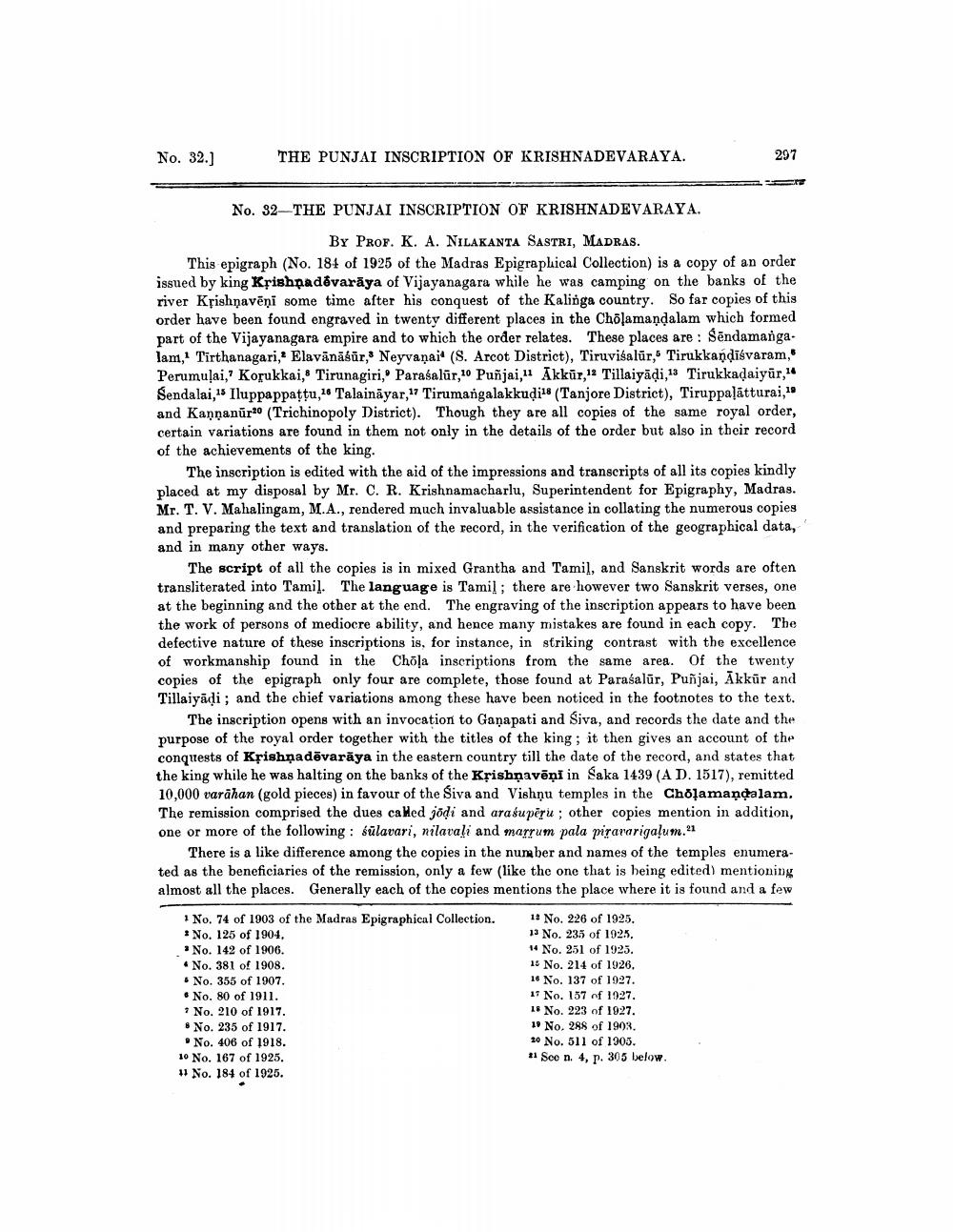________________
No. 32.]
THE PUNJAI INSCRIPTION OF KRISHNADEVARAYA.
297
No. 32-THE PUNJAI INSCRIPTION OF KRISHNADEVARAYA.
BY PROF. K. A. NILAKANTA SASTRI, MADRAS. This epigraph (No. 184 of 1925 of the Madras Epigraphical Collection) is a copy of an order issued by king Krishnadevarāya of Vijayanagara while he was camping on the banks of the river Krishnavēņi some time after his conquest of the Kalinga country. So far copies of this order have been found engraved in twenty different places in the Cholamandalam which formed part of the Vijayanagara empire and to which the order relates. These places are: Sendamanga. lam, Tirthanagari, Elavänäsür, Neyvanai (S. Arcot District), Tiruvisalur, Tirukkandisvaram, Perumulai, Korukkai, Tirunagiri, Parasalūr,20 Puñjai, Akkūr, Tillaiyādi,13 Tirukkadaiyür," Sendalai, Iluppappattu,26 Talaināyar, 17 Tirumangalakkudi8 (Tanjore District), Tiruppaļatturai, 19 and Kannanūra (Trichinopoly District). Though they are all copies of the same royal order, certain variations are found in them not only in the details of the order but also in their record of the achievements of the king.
The inscription is edited with the aid of the impressions and transcripts of all its copies kindly placed at my disposal by Mr. C. R. Krishnamacharlu, Superintendent for Epigraphy, Madras. Mr. T. V. Mahalingam, M.A., rendered much invaluable assistance in collating the numerous copies and preparing the text and translation of the record, in the verification of the geographical data, and in many other ways.
The script of all the copies is in mixed Grantha and Tamil, and Sanskrit words are often transliterated into Tamil. The language is Tamil; there are however two Sanskrit verses, one at the beginning and the other at the end. The engraving of the inscription appears to have been the work of persons of mediocre ability, and hence many mistakes are found in each copy. The defective nature of these inscriptions is, for instance, in striking contrast with the excellence of workmanship found in the Chola inscriptions from the same area. Of the twenty copies of the epigraph only four are complete, those found at Paraśalūr, Puñjai, Ākkūr and Tillaiyādi; and the chief variations among these have been noticed in the footnotes to the text.
The inscription opens with an invocation to Ganapati and Siva, and records the date and the purpose of the royal order together with the titles of the king; it then gives an account of the conquests of Krishṇadēvarāya in the eastern country till the date of the record, and states that the king while he was halting on the banks of the Krishnavēņi in Saka 1439 (A D. 1517), remitted 10,000 varāhan (gold pieces) in favour of the Siva and Vishnu temples in the Cholamandalam, The remission comprised the dues called jõdi and arasuperu; other copies mention in addition, one or more of the following: sūlavari, nilavali and marrum pala pirararigalum.21
There is a like difference among the copies in the number and names of the temples enumerated as the beneficiaries of the remission, only a few (like the one that is being edited) mentioning almost all the places. Generally each of the copies mentions the place where it is found and a few
1 No. 74 of 1903 of the Madras Epigraphical Collection. * No. 125 of 1904,
No. 142 of 1906. • No. 381 of 1908. * No. 355 of 1907. • No. 80 of 1911. * No. 210 of 1917.
No. 235 of 1917. .No. 406 of 1918. 10 No. 167 of 1925. # No. 184 of 1925.
12 No. 226 of 1925. 13 No. 235 of 1925. 14 No. 251 of 1925. 16 No. 214 of 1926. 16 No. 137 of 1927. 17 No. 157 of 1927. 18 No. 223 of 1927. 19 No. 288 of 1903. 20 No. 511 of 1905. 11 Soe n. 4, p. 305 below.




